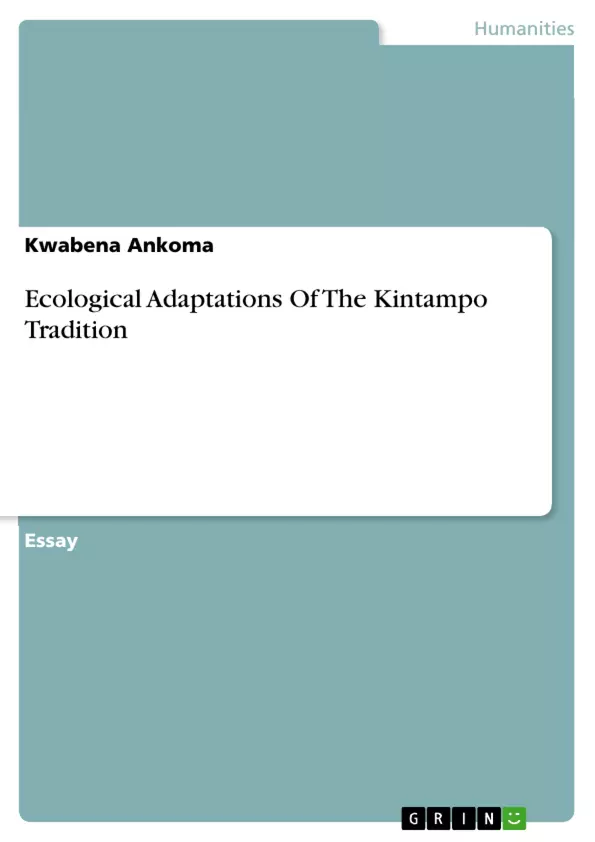The Kintampo tradition of Ghana (3600-3000 BP) as described is associated with the earliest manifestations of figurative art, personal adornment, semi-sedentary "village" settlements and food production in the Late stone Age (L.S.A) of the savannah forests of West Africa. These societies were spread through the whole of Ghana from the coast to the northern part of Ghana. They were located at Mumute, Bonoase, Boyase hill, Birimi, Ntereso, Christian village, K6, B sites, Kpiri, Buoho and Gambaga. It should however be noted that detail research have been done in only a few sites.
Before the advent of the Kintampo tradition, there was the Punpun phase (originally called Buobini) which preceded the Kintampo tradition. The Punpun phase consisted of late Stone Age (L.S.A) societies who sparsely inhabited the whole of Ghana. These societies subsisted based on hunting and gathering of food and were also mobile. Due to their mobility there is the absence of non-portable artifacts like grinding stone and the rarity of ceramics.
Table of Contents
- PUNPUN PHASE
- WHY KINTAMPO?
- DIAGNOSTIC FEATURES
- KINTAMPO CONTROVERSY
- MUMUTE
- BOYASI HILL
- GAMBAGA
- K6
- Faunal Remains
- NTERESO
- BONOASI
Objectives and Key Themes
This text explores the Kintampo tradition, a significant Late Stone Age (L.S.A) culture in Ghana that marked the early stages of figurative art, personal adornment, semi-sedentary settlements, and food production in West Africa. The text delves into the origins and development of this tradition, examining its unique features, contrasting viewpoints on its geographic origination, and providing detailed insights into various sites associated with the Kintampo tradition.
- Origins and Development of the Kintampo Tradition
- Diagnostic Features of the Kintampo Tradition
- The Controversy Surrounding the Kintampo Tradition's Origins
- Archaeological Findings at Key Kintampo Tradition Sites
- Evidence for Early Domestication and Subsistence Practices
Chapter Summaries
- PUNPUN PHASE: This section introduces the Punpun phase, a precursor to the Kintampo tradition. It describes the societies of this phase as mobile hunter-gatherers inhabiting Ghana, characterized by the absence of non-portable artifacts and limited evidence of ceramics.
- WHY KINTAMPO?: This section explains the origin of the name "Kintampo," which derives from the first site where evidence of the tradition was found. It highlights the significance of the Kintampo tradition for understanding early sedentary practices and domestication in West Africa.
- DIAGNOSTIC FEATURES: This section outlines the characteristic features of the Kintampo tradition, including terracotta cigars, groundstone artifacts, unique ceramics, structural evidence of settlements, and evidence of ornamentation and early artistic expressions. It also emphasizes the importance of these features in understanding the evolution of the tradition.
- KINTAMPO CONTROVERSY: This section explores the ongoing debate regarding the geographic origination of the Kintampo tradition. While some scholars argue for a northern origin based on cultural similarities, others support the notion of indigenous innovation within West Africa.
- MUMUTE: This section focuses on the archaeological findings at the Mumute site, including terracotta cigars, broken clay figurines, and evidence of structural features. It highlights the presence of early figurative arts and provides insights into the construction methods employed by the Kintampo people.
- BOYASI HILL: This section presents the unique findings at the Boyasi Hill site, including polished arrow points, structural features, stone beads, and broken clay figurines. It connects these discoveries to similar finds in other regions.
- GAMBAGA: This section discusses the archeological evidence from Gambaga, including unique polished arrow points, similar to those found at Boyasi Hill, and structural features that resemble those observed at other Kintampo tradition sites.
- K6: This section provides a comprehensive overview of the archaeological evidence from the K6 site. It examines the presence of Nyame akuma, structural features, faunal remains, and evidence of domestication and trade activities.
- NTERESO: This section examines the findings at the Ntereso site, including projectile points, structural features, domestic ovicaprids, and diverse faunal remains. It highlights the presence of fishhooks and harpoon joints, suggesting a connection to aquatic resources.
- BONOASI: This section concludes the chapter summaries by exploring the archeological evidence from the Bonoasi site. It focuses on the presence of structural features and stone figurines, highlighting the continuity of the tradition's artistic expression.
Keywords
The key terms and concepts explored in this text include the Kintampo tradition, Late Stone Age (L.S.A), figurative art, personal adornment, semi-sedentary societies, food production, domestication, terracotta cigars, groundstone artifacts, structural features, faunal remains, trade, diffusion, and indigenous innovation. The text focuses on the archaeological evidence from specific sites like Mumute, Boyasi Hill, Gambaga, K6, Ntereso, and Bonoasi, analyzing the material culture and providing insights into the cultural practices and societal development of the Kintampo tradition in Ghana.
- Quote paper
- Kwabena Ankoma (Author), 2012, Ecological Adaptations Of The Kintampo Tradition, Munich, GRIN Verlag, https://www.grin.com/document/889365




